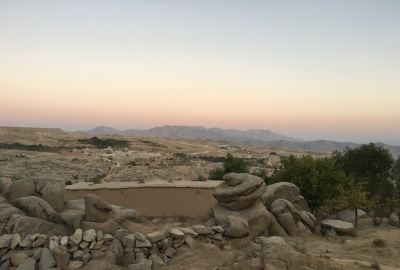
Design
ALSE is a multi-year impact evaluation that aims to expand and deepen our understanding of ways (1) to maximize primary school learning and access through community-based education (CBE) — Phase One, and (2) to sustain these gains in learning and access into the future — Phase Two. It studies the Community-Based Education Enhancement Program (CBEEP) being implemented by CARE Afghanistan and CRS Afghanistan in six provinces in Afghanistan: Bamiyan, Daykundi, Ghor, Herat, Kapisa, and Parwan.
Phase One research focused on questions related to the first theme by studying the impact of different CBE models —teacher recruitment variation and community engagement variation — on children’s enrollment and learning outcomes. Phase Two research examines a CBE sustainability model under community-management in an effort to shed light on the question, “how can gains from CBE continue after NGO programming ends?”
To understand the effects of the CBEEP program, ALSE’s sample includes 195 villages randomly assigned to one of four models (described below) as well as to either an “early handover” (after year three) or “late handover” option for the transition away from NGO management to a community-managed model.
Teacher Recruitment Models
One key challenge in ensuring high quality and sustainable education is teacher hiring practices. There is frequently a perceived trade-off between hiring a teacher familiar to the community, who often has lower qualifications, and hiring one who meets the minimum qualifications of the Afghan Ministry of Education (MoE). Parents may be more comfortable sending their children to a class that is taught by someone they know and, furthermore, teachers from the village are likely to have fewer absences. However, local teachers may not hold the minimum teaching credentials required by the MoE.
Because the villages where community-based schools are established are so remote, it is not always possible to hire teachers who meet both criteria—i.e., they are both familiar to the community and meet MoE standards. Furthermore, it is unclear whether hiring teachers without the MoE requirements actually leads to lower levels of learning.
In each village included in the ALSE study, the preference was to hire teachers with the MoE required minimum twelfth-grade education. However, villages in which no such teacher was available were assigned to one of two teacher recruitment models:
1. Recruiting from “within” the community:
This model prioritized community ownership and acceptance by recruiting teachers from within the community on the basis of personal capabilities even if they did not have a twelfth-grade education (as currently happens among many community-based schools). These teachers were provided training to address any capability gaps and prepare them for teaching the CBE classes.
2. Recruiting accredited teachers:
This model prioritized teacher qualifications by recruiting externally for those possessing at least a twelfth-grade education. Teachers were recruited from a nearby village, the district center, or the provincial center. In order to minimize problems associated with community acceptance of “outsider” teachers, the NGOs attempted to ensure a good match between teachers and communities by conducting trust-building efforts in recipient communities and training teachers on approaches to working with host communities.
Community Engagement Models
Supporting “community participation” to enhance educational outcomes is among the most common interventions in NGO-administered programs. Community involvement is widely assumed to boost the quality of children’s learning, especially girls’, and be an influential factor in the sustainability of social services. However, evidence of its effects are mixed (Pradhan et al. 2007; Bold et al. 2012). Greater community involvement in decision-making (e.g., via village referenda) aligns development programs more closely with the preferences of regular community members (not just community elites) and increases local satisfaction with programming that could improve sustainability (Beath et al. 2012). Our research adds to this discussion by examining whether increasing community engagement can improve learning outcomes and whether it can help sustain access to schools and learning after the transition is made from NGO management to community management. Treatment villages were assigned to two variations of community engagement models.
1. NGOs standard community sensitization practice (status quo):
The first community engagement model is characterized by the NGO’s standard practice aimed at building community awareness of the benefits of education and buy-in for educating children, especially girls. Following the MoE’s policy for implementing CBE, NGOs mobilize communities to establish five-member school shuras in each CBE community. NGOs support the school shuras to conduct social audits in order to build public accountability for educational quality and other community services. School shuras facilitate bi-annual meetings with parents, caregivers, and other community stakeholders to discuss school affairs and solve problems, raise awareness of their children’s performance, and celebrate education achievements. All activities work to incorporate the participation and perspectives of women from the local community—in the same meetings if possible, or in separate meetings, if not.
Whenever possible, NGOs also facilitate links between school shuras and other MoE outreach classes, as well as MoE hub schools, Community Development Councils (CDCs) and other relevant stakeholders. The goal is to engage a wider range of actors in supporting education development and dialogue within their communities, strengthen local education structures and build sustainable relationships among community members within school clusters.
2. Enhanced community sensitization activities (status quo plus):
In this model, NGOs augmented the standard community sensitization package by including additional programming through (1) pro-education messaging and (2) small-scale adult learning programs. During the first year of CBE programming, NGOs worked with local leaders to develop education messaging that was relevant to village communities. After the messaging was approved by local authorities, NGOs disseminated posters to the mosque(s) and all households in villages assigned to this variation. Second, these communities received community libraries that hosted small-scale adult learning programs (not full adult literacy programs). These monthly Adult Reading Group sessions taught parents techniques for supporting their children’s education. They were led by one male and one female community library manager, both of whom were volunteers.
Sustainability
For communities that do not have access to the formal government school system because of distance, geographic barriers, or security, CBE provides education that would have otherwise been unattainable. However, the gains made by CBE at the village level can be fleeting due to temporary NGO funding. To deepen our understanding of sustained access and learning, ALSE’s Phase Two examines the central question of how the gains from CBE can be sustained. Local management of CBE, with community institutions playing a strong role, may prove to be a viable option for CBE sustainability and the provision of local education more broadly. To examine the effectiveness of community institutions in the management of education, ALSE worked with our partner NGOs and the MoE to transition CBE classes from NGO management to community-management. The community-management structure in the ALSE research is modeled on the framework presented by the Citizen’s Charter (CC) National Priority Program. Community institutions (locally know as shuras) were tasked with managing and administering the CBE classes while ALSE provided a light stream of funding to cover teacher salaries and basic classroom materials. To evaluate the effectiveness of community-management of education, ALSE will compare access and learning outcomes between the villages where the CBE classes were managed by community institutions and the villages where the classes remained under NGO administration after one full academic year. Phase Two of the study will contribute to our understanding of the material, political, and institutional challenges to providing essential public services in conflict-affected environments (Besley and Persson 2011), and help to reveal ways to improve this capacity in line with current national and education policy.

